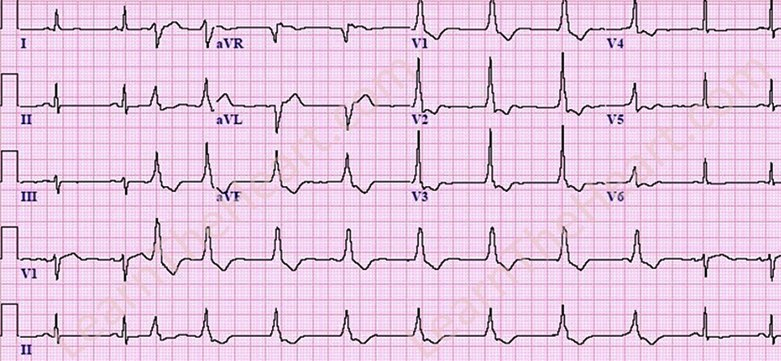ECG Reviews
Idioventricular Rhythms ECG Review
An idioventricular rhythm is very similar to ventricular tachycardia except the ventricular rate is less than 60 beats per minute.
All other characteristics of VT apply; this includes the presence of atrioventricular dissociation, as seen in the ECG and strip below, and the Brugada Criteria. An idioventricular rhythm is frequently referred to as a “slow ventricular tachycardia” for this reason.
When the ventricular rate is between 60 and 100 bpm, it is referred to as an accelerated idioventricular rhythm. This is a hemodynamically stable rhythm that occurs commonly after myocardial infarction and no treatment is needed.
Example #1
This ECG displays an accelerated idioventricular rhythm. This has a left bundle branch block pattern and is a good example of the AV dissociation that occurs. Now, look at the rhythm strip at the bottom in lead V1 to see the AV dissociation. This ECG also meets the Brugada Criteria for concordance. In this LBBB pattern, all the QRS complexes are negative in the precordial leads.
Example #2
In this ECG example of AIVR, note the right bundle branch block pattern and upward concordance, with all the QRS complexes up in the precordial leads V1 to V6 during the wide complex rhythm. Recall that the morphology of the QRS complex (right or left bundle) depends on from where the focus of the ventricular rhythm originates (right or left ventricle). If the rhythm starts in the left ventricle, then the electrical activation takes longer to get to the right ventricle, and a RBBB pattern will occur. Likewise, if the rhythm originates in the right ventricle, then the left ventricle will take longer to depolarize, and the QRS complex pattern will appear similar to a LBBB.
ECG Examples:
- Accelerated Idioventricular Rhythm - Slow Ventricular Tachycardia (VT) ECG (Example 1)
- Accelerated Idioventricular Rhythm - Slow Ventricular Tachycardia (VT) ECG (Example 2)
- Accelerated Idioventricular Rhythm - Slow Ventricular Tachycardia (VT) ECG (Example 3)
References:
1. Chou’s Electrocardiography in Clinical Practice: Adult and Pediatric, 6e
2. Surawicz B, et al. AHA/ACCF/HRS Recommendations for the Standardization and Interpretation of the Electrocardiogram. Circulation. 2009;doi:10.1161/CIRCULATIONAHA.108.191095.


